Kigali, Rwanda
The church at Ntarama, a 45-minute drive south of Rwanda’s capital, Kigali, is a red-brick building about 20 metres long by 5 metres wide. Inside are features seen in Catholic churches around the world: pews for congregation members, an altar, stained-glass windows and a cross adorning the entrance. Then there are the scars of the unimaginable: piles of blood-stained clothing hanging along the walls and glass cabinets containing more than 260 human skulls, many fractured or shattered, some with rusted weapons still penetrating them. Nearby, wooden sticks and roughly carved clubs lean against the altar.
Ntarama is the site of one of the many massacres that occurred during the 1994 genocide against the Tutsi in Rwanda — one of the worst atrocities of the late twentieth century. Starting on 7 April that year, in 100 days of horrifying violence, members of the Hutu ethnic group systematically killed an estimated 800,000 Tutsi — or more than one million, according to the Rwandan government and other sources. The killers ranged from militias to ordinary citizens, with neighbours turning on neighbours. Many moderate Hutu and some of the Twa minority group were also killed.
Rwanda: From killing fields to technopolis
More than 5,000 Tutsi were murdered at Ntarama, among them babies, children and pregnant women, many of whom were raped before they were killed, says Evode Ngombwa, site manager at the Ntarama Genocide Memorial, one of six sites in Rwanda that commemorate the atrocity. “People used money to bribe the perpetrators so that they could choose the way of being eliminated. Instead of killing them with machetes, they could choose to be shot,” says Ngombwa as he walks me through the church. With more remains being found each year, about 6,000 people are now buried there in mass graves.
This month, Rwanda and the world begin commemorations to mark 30 years since the start of this atrocity. The genocide is now one of the most studied of its kind. Researchers from social and political scientists to mental-health specialists, geneticists and neuroscientists have investigated the event and its aftermath in a way that hadn’t been possible for previous atrocities.
This work is especially important now in light of violent crises in several parts of the world, including in Ukraine, Israel and Gaza, Sudan and the Democratic Republic of the Congo. Although there is debate about whether these conflicts meet the definition of genocide, some share similar characteristics. Research conducted into atrocities such as the genocide in Rwanda can help to inform responses and longer-term approaches to healing.
Despite the difficulties of these studies, researchers say that they are working towards developing a theory of genocide and the conditions that spur mass violence. They are providing guidance for first responders, as well as those involved in peacebuilding and supporting survivors of other systematic mass murders and of war. Some of their approaches have been used in other conflicts. And the research on Rwanda is offering lessons for how scholars can improve studies of similar events.
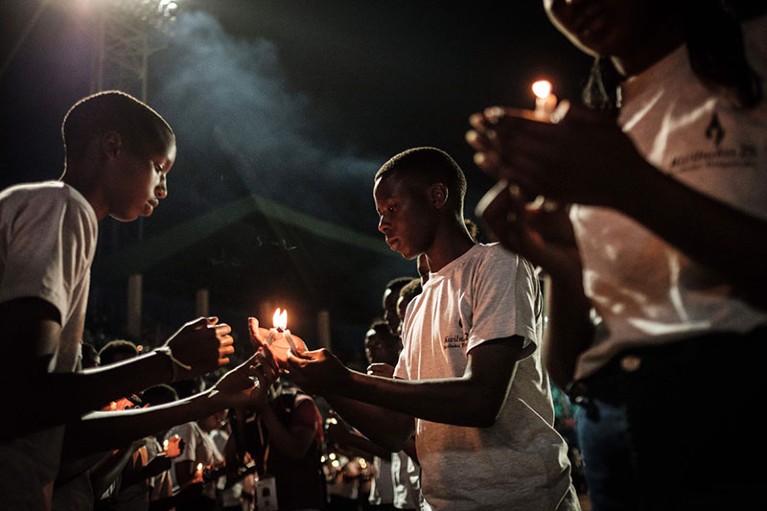
At a vigil in April 2019, young Rwandans commemorate the 25th anniversary of the genocide.Credit: Yasuyoshi Chiba/AFP/Getty
“Genocide studies are important,” says Phil Clark, an international-politics researcher at SOAS, part of the University of London, who has studied Rwanda for more than two decades. “If we can start to understand why and how genocides happen, and especially if we can compare genocides across the world, we should ideally be able to build a general theory of how these terrible events are even possible.”
One of the lessons emerging from Rwanda is the importance of involving — and supporting — local researchers, whose work, language skills and access to traumatized communities can be essential for understanding the roots of violence and the best techniques for reconciliation. This can be difficult — in Rwanda’s case because the genocide wiped out almost its entire academic community. Now, through programmes aimed at elevating local scholars’ voices, their work is finally reaching a wider audience.
Patterns of violence
Before 1994, the field of genocide studies was dominated by the Holocaust — the systematic killing of 6 million Jewish people by Nazi Germany during the Second World War. “It’s only in the last 20 years that other genocides have entered the discussion,” says Clark. But research on Rwanda didn’t start immediately. “It was only maybe 10–15 years after the genocide that scholars started to really interrogate this question of what drove hundreds of thousands of everyday civilians to participate in mass violence.”
Rwanda 30 years on: understanding the horror of genocide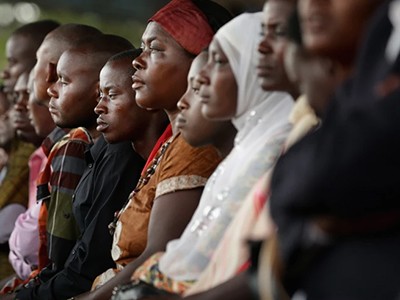
Scholars say that it’s important not to forget the genocide’s strong link to colonialism in Rwanda. In the early 1900s, Belgian colonizers began formally dividing Rwandan people into social classes: Hutu, Tutsi and Twa. Designations were often based on pseudoscientific ideas, including phrenology and arbitrary observations, such as how many cattle a person owned. Ethnic tensions between Hutu and Tutsi intensified over the decades and several massacres of Tutsi occurred in the period leading up to 1994. This set the stage for a descent into genocide — a legal term that is defined by the perpetration of certain crimes that are intended to destroy a particular group, and is codified by the United Nations’ 1948 Genocide Convention.
Each genocide is unique, says Timothy Longman, a political scientist at Boston University in Massachusetts, who first went to Rwanda in 1992 and returned in 1995 as a researcher with Human Rights Watch, an international non-governmental organization that was one of the first to investigate the event. “But there also are some common patterns,” he says. Researchers can learn a lot from studying cases such as Rwanda, the Holocaust and other genocides, he says. “It helps you to prevent violence from happening elsewhere.”
One of the main scientific contributions of studies so far are the insights from mental-health researchers, many of whom were on the ground in the immediate aftermath. Over the past three decades, they have documented the initial trauma of an entire country and the slow recovery of survivors and their children, many of whom are prone to being retraumatized. With few available resources, Rwanda had to build up its mental-health services and it has gained unique experience in responding to the atrocity’s aftermath.
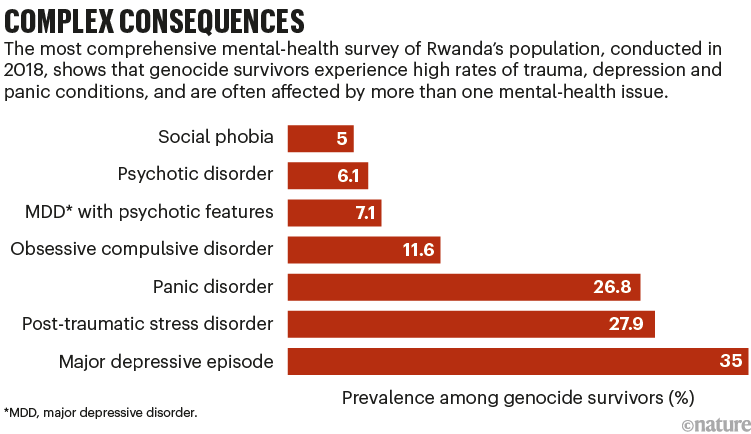
Source: Y. Kayiteshonga et al. Rwanda Mental Health Survey 2018 (Govt of Rwanda, 2021).
At the Rwanda Biomedical Centre (RBC) in Kigali, the nation’s main health organization, Jean Damascène Iyamuremye recalls his experience of 1994. “I witnessed everything that happened.” Iyamuremye was a 28-year-old training to be a medical assistant, but the genocide spurred him to specialize in mental health. He was among the first medical staff supporting survivors. “We were like firefighters,” says Iyamuremye, who is now director of the psychiatric unit in the RBC’s mental-health division, which oversees countrywide services.
The first care came mostly from outsiders. Non-governmental organizations provided psychological interventions such as counselling for the survivors, most of whom had experienced physical violence as well as unimaginable emotional trauma from the mass killings they’d witnessed. After the genocide, 96% of Rwandans experienced post-traumatic stress disorder (PTSD) as a result of the extreme violence1.
It took time for the country to develop its own mental-health resources. In 1994, Rwanda had only one psychiatrist, Naasson Munyandamutsa, who was living in Switzerland at the time and lost most of his family in the violence. Munyandamutsa returned quickly to Rwanda to work at the country’s sole psychiatric hospital, where he began training mental-health responders and psychiatrists.
While Munyandamutsa, who died in 2016, led the training of practitioners in Rwanda, many Rwandans went overseas to train. But about half didn’t return, says Iyamuremye.
It wasn’t until 2014 that Rwanda had its own school of psychiatry, at the University of Rwanda in Kigali. Even now, the country has only 16 psychiatrists, 13 of whom graduated from that facility, to serve a fast-growing population of 13.5 million.
Evidence-based interventions for survivors, such as counselling, cognitive behavioural therapy and medication, have continued — but people still bear significant mental scars from their experiences (see ‘Complex consequences’). In Rwanda’s most comprehensive mental-health survey yet, conducted by the RBC in 2018, about 28% of genocide survivors reported PTSD symptoms, compared with 3.6% of the general population (see ‘Trauma’s long shadow’).
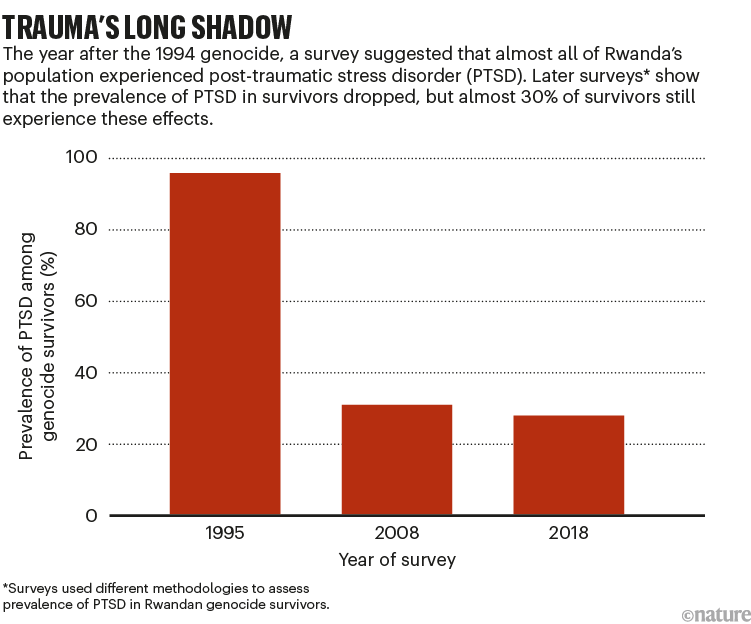
Sources: Ref. 1; A. Eytan et al. Int. J. Soc. Psychiatr. 61, 363–372 (2015); Y. Kayiteshonga et al. Rwanda Mental Health Survey 2018 (Govt of Rwanda, 2021).
Long-term support for survivors is important, because many can become retraumatized. For example, media reports about violence in nearby parts of the Democratic Republic of the Congo can bring back memories, says Iyamuremye. And yearly commemorations that last from April to July, called kwibuka in the national language, Kinyarwanda, bring challenges. “You will see people who fall, who are agitated, who cry” because what they experience triggers a memory, says Iyamuremye.
For this year’s commemorations, the RBC and other organizations have trained 5,000 responders around Rwanda to support distressed people. But Iyamuremye and his colleagues have learnt that the commemorations themselves can be therapeutic: they give people the opportunity to talk about their trauma and support each other.
And researchers have found that even people who weren’t alive during the genocide are suffering. “Intergenerational trauma is a challenge and a reality in Rwanda. This needs to be targeted with strong, strong interventions,” says Iyamuremye.
Trauma across generations
At the Rwanda Military Hospital on Kigali’s outskirts, Léon Mutesa, a physician and, for a long time, the nation’s only geneticist, is seeing mothers and babies at his paediatric clinic. Mutesa, who directs the Center for Human Genetics at the University of Rwanda, was the first to explore the effects of Rwandans’ trauma at the genetic level. As an undergraduate in the early 2000s, Mutesa saw that children born to women who had been pregnant in 1994 also exhibited signs of trauma. During commemorations, the children expressed symptoms such as PTSD, depression, anxiety and hallucinations from an event that they hadn’t experienced.
Inspired by studies of Holocaust survivors2, Mutesa devised a small study to investigate whether the trauma from the genocide had left epigenetic marks on individuals’ DNA through the addition of methyl groups to certain regions.
In that study3, conducted in 2012, Mutesa’s team sampled blood from women who were pregnant in 1994 and their children, as well as control participants who weren’t exposed to the genocide. The team found evidence that genocide survivors and their children bore similar epigenetic marks on certain sections of DNA.
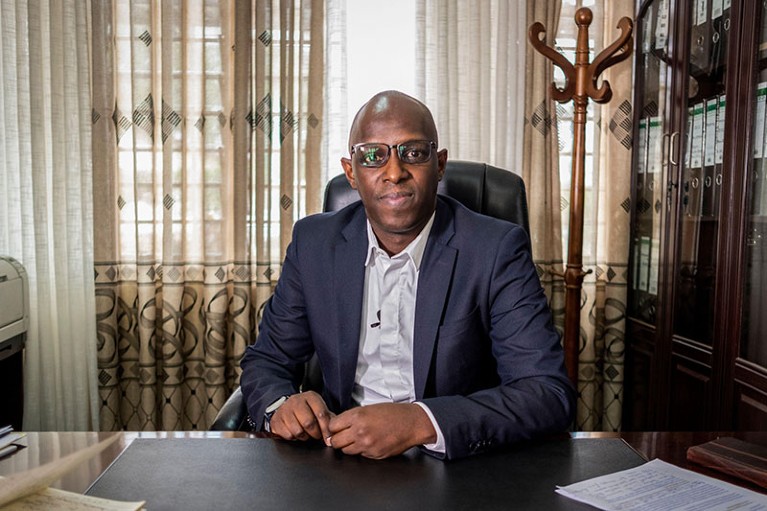
Geneticist Léon Mutesa has studied DNA markings in genocide survivors and their children.Credit: AP Photo
Hoping to start a larger study, Mutesa collaborated with Stefan Jansen, a Belgian neuroscientist who had been at the University of Rwanda since 2011. In 2017, the pair, with US partners, won funding from the US National Institutes of Health to extend their investigations.
“We found that those mothers who were exposed had around 24 differentially methylated regions, which is really high compared to the control group,” says Clarisse Musanabaganwa, a medical research analyst at the RBC who was part of Mutesa and Jansen’s team. The team found that many of the methylated regions were the same in mothers and in the children that they were pregnant with during the genocide4,5. The research indicates a way in which trauma can transcend at least one generation, and the researchers suggest that lasting effects could be passed down through multiple generations through a mechanism of epigenetic inheritance.
But the idea of multigenerational epigenetic inheritance is controversial. Many scientists are sceptical about whether methylation marks on DNA in humans can be inherited.
“I’m not aware of any really convincing case where the transgenerational inheritance — inheritance of methylation patterns — has been demonstrated,” says Timothy Bestor, a molecular biologist in Gaylordsville, Connecticut, who holds an emeritus position at Columbia University in New York City.
But Mutesa and Jansen are seeing some practical benefits of their work. When the scientists discussed with study participants that their trauma could influence their children, they saw the participants’ resilience increase. For instance, if survivors’ children were performing poorly in school, parents now saw a possible reason. The researchers could support children with psychotherapy. “They could now understand why this is happening to their children,” says Mutesa.
Biological studies also have a broader importance, says Jansen. “We want to evidence that, and have that recorded for history: this is what happened.” The evidence helps to fight genocide denial, he says.
Beyond the epigenetic analyses, Jansen and his colleagues have strengthened methodological approaches to studying community mental health in Rwanda. These studies have informed research on conflicts elsewhere, such as in Iraq, says Jansen.
Lessons from Rwanda
The bulk of the research on the genocide in Rwanda has been in the social sciences and humanities — studying topics from reconciliation, peacebuilding and justice to the role of ethnic designations in a society after conflict. For instance, neighbouring Burundi, which experienced ethnic violence in a roughly decade-long civil war that started in 1993, chose to recognize ethnicities, whereas the Rwandan government eradicated formal ethnic distinctions after the genocide. In a global study6 that compared countries that had taken either approach after war, those that chose to recognize ethnic groups scored better on societal markers such as peace, democracy and economics.
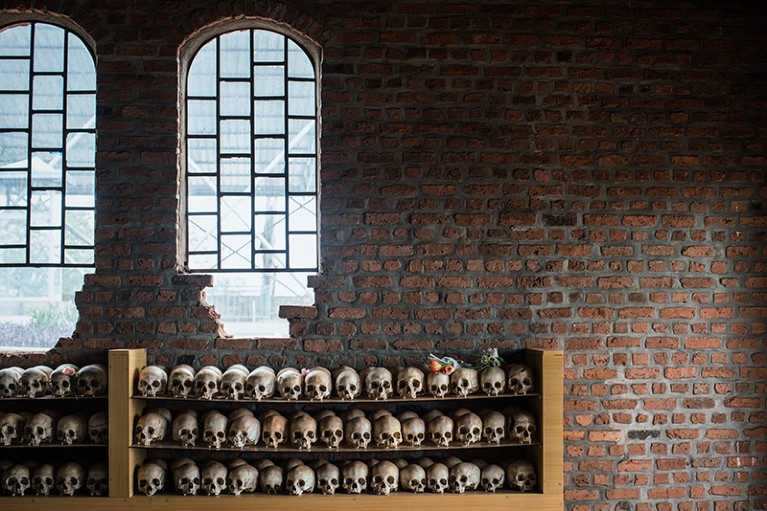
Some of the skulls of people who were killed while seeking refuge at Ntarama in April 1994 are on display in the church.Credit: Nichole Sobecki/VII/Redux/eyevine
The growing literature on genocides has revealed that they have huge ramifications that extend well beyond the borders of the countries where they happen, say researchers.
“In terms of the scale of violence, the scale of disruption, the scale of suffering, they are enormously important events,” says Scott Straus, a political scientist at the University of California, Berkeley.
Studies had been conducted almost exclusively by Western scholars — although that’s starting to change. In the past decade, as discussions of decolonizing research began in academia, Clark started working with the UK-based Aegis Trust, which runs the Kigali Genocide Memorial. An analysis by Clark and his colleagues of 12 relevant journals showed that from 1994 to 2019, just 3.3% of studies on post-genocide Rwanda had been done by scholars from the nation (see go.nature.com/3qapae7). In 2014, with funding from the Swedish and UK development agencies, the Aegis Trust launched the Research, Policy and Higher Education (RPHE) programme, an effort to invite Rwandan scholars to submit research proposals.
“There are cultural nuances that have to be told by the very people that go through those experiences,” says Sandra Shenge, who is director of programmes at the Aegis Trust based at the Kigali Genocide Memorial, and former RPHE manager. The grants were modest — just £2,500 (US$3,150) each. But the response to the programme was amazing, says Shenge. The first call received more than 500 applications.
The aim was for Rwandan scholars to share their stories and for external researchers to provide support with advice on methodology, publishing and how best to disseminate results. These studies are collected in a resource called the Genocide Research Hub.
“The RPHE was the best thing that happened to Rwandan researchers,” says Munyurangabo Benda, a philosopher of religion at the Queen’s Foundation, an ecumenical college in Birmingham, UK. “It is the only space where Rwandan research has begun to have impact on policy.”
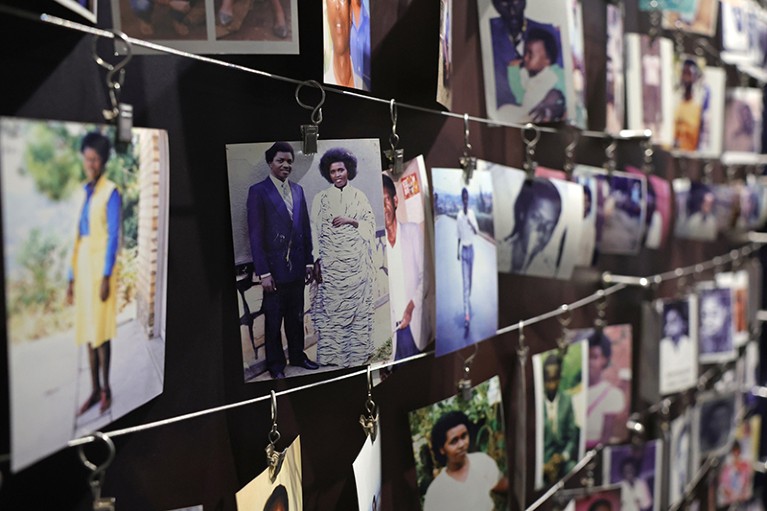
Photos of lives cut short by the 1994 killings are on display at the Kigali Genocide Memorial.Credit: Chris Jackson/Getty
Benda’s research7,8,supported by the RPHE, has already influenced policy. His project examined a state programme on reconciliation that had grown from a grassroots effort. His work exploring the guilt felt by children of Hutu people was inspired by the experience of his young nephew in Denmark, whose father was a Hutu. One day, his nephew’s class was studying the genocide in Rwanda and classmates asked him: “Were your family killers or survivors?” His nephew was traumatized.
The research helped to shape programmes that the Rwandan government offers for students of various ages, says Benda.
The RPHE programme also holds lessons for making the broader academic community more inclusive. According to Clark, “the problem is with journal editors and peer reviewers”, who often dismiss work from Rwanda and other countries because of preconceived ideas of quality based on where the work has been produced.
A theory of genocides
Another author whose work has been published through the Genocide Research Hub is sociologist Assumpta Mugiraneza9. From a hilltop office with views over Kigali, Mugiraneza runs an organization called the IRIBA Centre for Multimedia Heritage. Iriba means ‘source’ in Kinyarwanda, and the centre collects audio-visual archives of testimonies from the genocide and of life before 1994.
Mugiraneza says she started this work to capture Rwanda’s heritage, which was in danger of disappearing. The country’s historic oral traditions were eroded by colonization, which imposed reading and writing. As a result, Rwanda’s history is written without this richer heritage, says Mugiraneza. “Let’s go back to what we have in common: sound and image.”

Sociologist Assumpta Mugiraneza runs the IRIBA Centre for Multimedia Heritage.Credit: Carl De Keyzer/Magnum Photos
The centre, she says, is designed “to support the process of reappropriating the past”. To think about genocide, “we must dare to seek humanity where humanity has been denied”.
IRIBA’s work is extraordinary, says Zoe Norridge, who studies African literature and culture at King’s College London. “That’s the kind of work that can be done by Rwandan scholars in depth in a way that I think outsiders never really reach.”
Researchers agree that studying atrocities is a difficult undertaking. “Research involves talking to survivors who have endured unimaginable horror and putting yourself in the position to listen and hear and be empathetic,” says David Simon, who directs the Genocide Studies Program at Yale University in New Haven, Connecticut.
Still, scholars say that, through these studies, they are developing a broader understanding by identifying similarities among different genocides. These include what happened in Rwanda and the Holocaust, as well as in the genocide of the Armenian people in 1915 and of the Herero and Nama people in what is now Namibia, starting in 1904.
All of them shared common ingredients, according to researchers. The first is racializing members of society and identifying an ‘inferior’ segment of the population to be eliminated. Other factors include planning organized massacres and spreading an ideology across a whole society. The last component is the involvement of the state and its institutions, such as religious establishments and schools, as participants in the killings, says historian Vincent Duclert, who is France’s leading scholar on the 1994 genocide.
Studies in Rwanda helped to solidify the theory, says Duclert. “This pattern was really reinforced by the genocide of the Tutsi.”
Another lesson from Rwanda, say researchers, is the need to seek multiple narratives — from people inside and outside the region, and from perpetrators as well as survivors. “In 1994, and in the years immediately after, there was a very simple narrative about the Rwandan genocide being driven by ancient tribal hatreds, and that it almost explained itself away,” says Elisabeth King, who studies peace, conflict and education at New York University. Scholars, says King, have a crucial part to play in developing nuanced accounts of the complex political and social factors that underlie these events. Those explanations, in turn, can help researchers and others to understand why people commit atrocities, and could ultimately contribute to developing approaches that help to stop them.
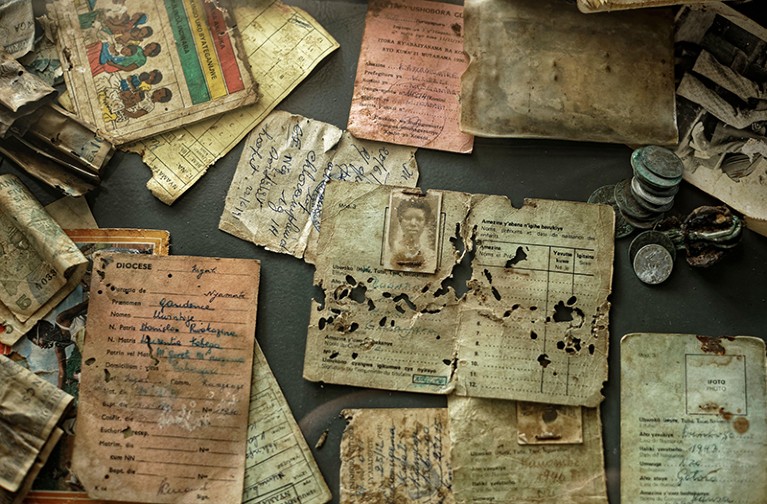
Belongings of people killed at Ntarama, including identity cards, which showed people’s ethnicities.Credit: Ben Curtis/AP Photo/Alamy
Straus is also studying causal factors shared by different genocides, and why some conflicts that have the ingredients of genocide do not escalate into them — violence in Mali in the 1990s and Côte d’Ivoire in the early 2010s are two examples10.
Some scholars say that studying genocides can yield many benefits, but that stopping them from happening is ultimately a political matter decided by nations and international bodies.
Aggée Shyaka Mugabe, acting director of the Centre for Conflict Management at the University of Rwanda, is pessimistic about the extent to which studying genocides can ultimately stop them. “What we publish informs public policies,” says Mugabe, who studies transitional justice and peacebuilding11. But that doesn’t translate into something everyday people can understand, he adds.
Some have also raised concerns that it can be difficult for Rwandan researchers to study topics related to genocide freely, because of pressure from the government to follow a certain narrative on politically sensitive issues. But Mugabe rejects the idea that research done inside Rwanda isn’t useful because of the perceived political pressure. “Some of my papers have a critical aspect,” he says. “There is no police trying to tell me what to write or what not to write.”
Survivors’ stories
One concern among scholars is that there has been less focus on elevating the voices of survivors, given that judicial inquiries focused so much on perpetrators.
Jean Pierre Sagahutu is one of those survivors. “I can’t tell you everything that happened in 1994 because it’s too hard,” he says. “I remember everything as if it were yesterday,” he says. “It’s as if I’m seeing it now.” Sagahutu survived by hiding in a septic tank for more than two months. In that time, his father and mother were killed. Originally trained as an accountant, Sagahutu began driving taxis after the genocide and worked as a ‘fixer’ for people visiting the country for projects, often interviewing génocidaires, the perpetrators of the violence against the Tutsi. “Sometimes my ears hurt, but it made me understand what the people had really done. And in the end, it became therapy.”
In 2019, he met Duclert, whom French President Emmanuel Macron had commissioned to conduct a study on France’s role in the genocide, owing in part to the French government’s support of Rwanda’s pre-genocide Hutu government. In 2021, Duclert presented his 1,000-page report12, which concluded that French authorities saw evidence of a coming genocide as early as 1990 but didn’t take enough measures to stop it.
Sagahutu takes positives from Duclert’s report, but says that scholars have more work to do: “I’d like researchers to try to learn, to really dig and find out what the real causes of the genocide were,” he says. “Because the genocide was not a game of chance, it was something that had been well prepared for a long time.”
One of the most important tools for researchers is recording the testimony of survivors, says Yolande Mukagasana, who wrote the first comprehensive survivor’s account of the genocide, which was published in French in 199713. Mukagasana, now 69, has remained a writer and activist, and is determined to keep the memory of the genocide against the Tutsi alive. As part of her work, she has talked to survivors of other genocides and mass killings and she sees similarities in these events, regardless of where in the world they happened. “The ideology of hate is the same,” she says, adding that survivors experience “exactly the same suffering”.
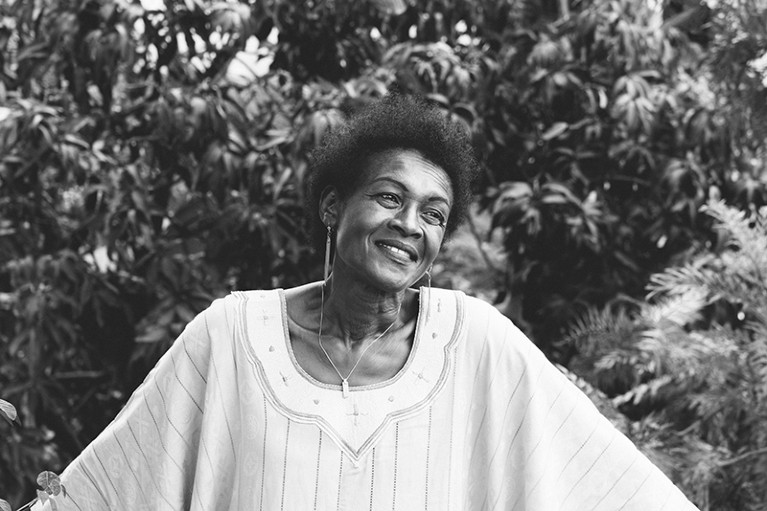
Yolande Mukagasana wrote the first comprehensive account of the genocide by a survivor.Credit: Chris Schwagga
In 1994, Mukagasana was a nurse and a successful Tutsi woman who ran her own health clinic. When the killings started, Mukagasana and her husband separated, hoping that their three children would be safer with him. During the months of the genocide, in which she was protected by Hutu people, she began writing her testimony on scraps such as cigarette packets.
Mukagasana’s husband and children were killed. When she reached safety at the Hôtel des Mille Collines — featured in the 2004 film Hotel Rwanda — one of the first things she wanted was a pen and paper to record what had happened.
At IRIBA, Mugiraneza knows the importance of documenting the events of 1994. But she also strives to collect evidence of life before. “The marriages. The love songs. The buildings, the proverbs, the stories — all those things that are so magnificent but are seen as trivial.”
“People negotiate a space for thinking, for giving meaning to life — which allows us to better understand what extermination and death are.”

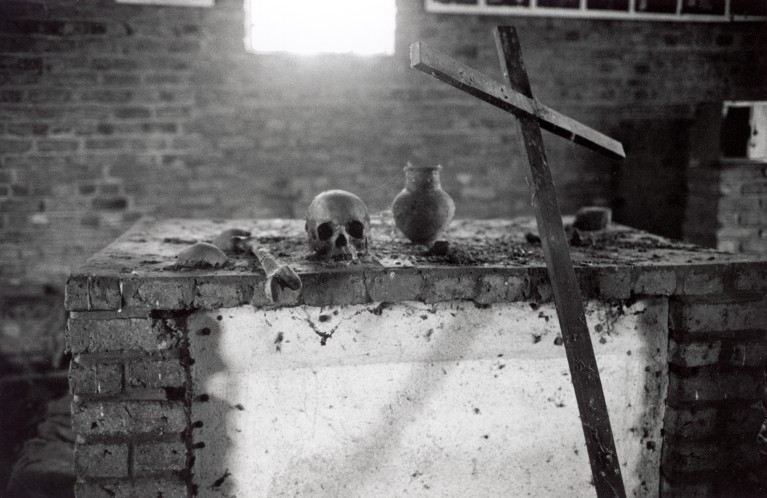
 Rwanda 30 years on: understanding the horror of genocide
Rwanda 30 years on: understanding the horror of genocide
 Rwanda: From killing fields to technopolis
Rwanda: From killing fields to technopolis
 ‘Armed groups entered the lab’: Sudan’s researchers flee violent military conflict
‘Armed groups entered the lab’: Sudan’s researchers flee violent military conflict
 How three Ukrainian scientists are surviving Russia’s brutal war
How three Ukrainian scientists are surviving Russia’s brutal war
 Sperm RNA carries marks of trauma
Sperm RNA carries marks of trauma







